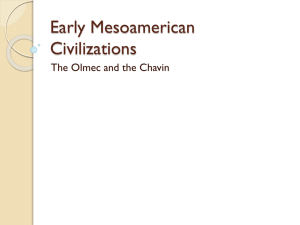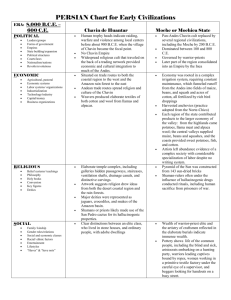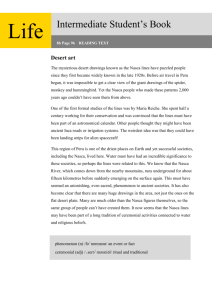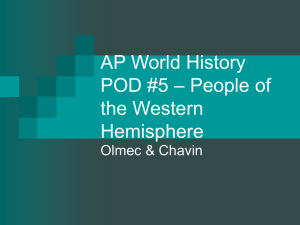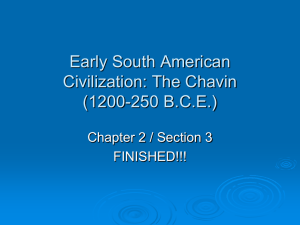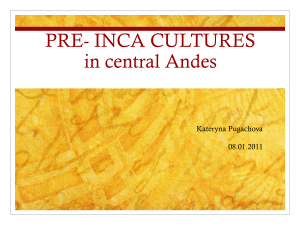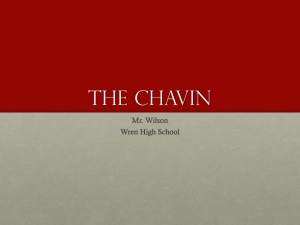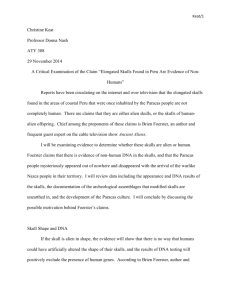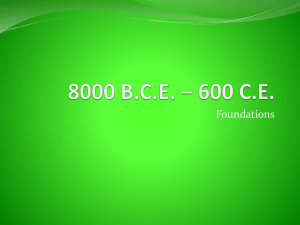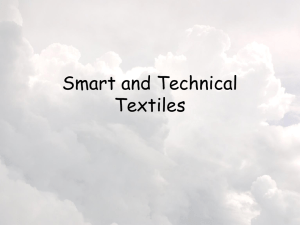Chavin de Huantar
advertisement
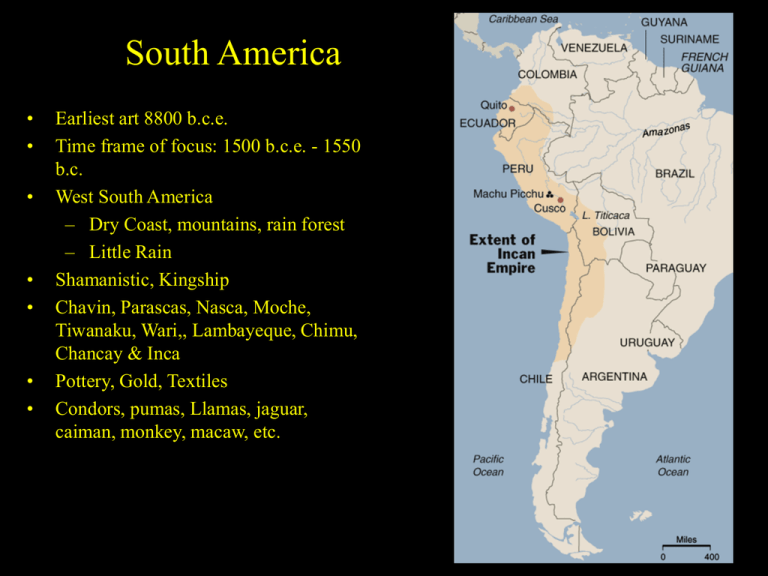
South America • • • • • • • Earliest art 8800 b.c.e. Time frame of focus: 1500 b.c.e. - 1550 b.c. West South America – Dry Coast, mountains, rain forest – Little Rain Shamanistic, Kingship Chavin, Parascas, Nasca, Moche, Tiwanaku, Wari,, Lambayeque, Chimu, Chancay & Inca Pottery, Gold, Textiles Condors, pumas, Llamas, jaguar, caiman, monkey, macaw, etc. Worldview • Commonalities – Huaca: “active interrelations” – Camay: “create, manifest, infuse with energy” – Ayni: “two make whole” (reciprocity, male/female) – Tinku: “two to make a third” – Pachakuti: embrace “change and flux” – Ukhu: “interior” that is concealed but important – Qumpi: preciousness, creativity, lavishness • Cyclicality • Sacred places, transference of energy Chapter 2: Early and Chavin: Lithic Period, 10,000-3,000 b.c.e. • Mummification –5000 b.c. –Chinchorro, Chile –Dry –Textiles –Sedge plants • Valdivia –4000 b.c.e. –Women –Fertility –Ritually killed Cotton Pre-Ceramic Period 3000-1800 b.c.e. • 3000 b.c.e. – Melting icecaps / floods • Textiles • Finger woven • Loom? • Huaca Preita – Weaving site – Twining – Warp (v)/ weft (h) • Raptor – Coiled snake • Hybridity • Ayni: 2 make whole Great Pyramid at Caral, 2800 b.c.e. • Earliest pyramid • 60’ • 30 structures • 160 acres • Plaster • White, yellow, red • Platforms • Enlargements – Shicras; rock fill Caral Ampitheater Temple of Crossed Hands, Kotosh, Huanuco (Peru), 2000-1800 b.c.e., • • • • • 2450 b.c.e. 2 Adobe mounds Buried Protection Duality Rock painting of Pregnant Vicunas, Cuchimachay, Peru • Pre-Ceramic period – 3000-1800 b.c.e. • • • • S. Peru Rock Shelters Hunting camps Camelids – Fertility – lifestyle • Fewer Humans Rock paintings, Cuchimachay, Peru Rock paintings, Cuchimachay, Peru Feline Head, Huaca de los Reyes, Caballo Muerto, PreCeramic, 1300 b.c.e., • Initial Period – 1800-800 b.c.e. – Sedentary – Looms – Fired clay statues – Pink, blue white – U-shaped structures • Facing mountain (apus) • Water –Feline Head • 5’7” • painted Lanzon Cult Image, Chavin, 900 – 200 b.c.e. • Shamanistic practices • Spiders, insects, toads Chavin de Huantar, Callejon de Conchucos, 1100-500 b.c.e. • • • • • • Valley U-shaped East facing Stone carvings Tenon heads White/black granite Chavin de Huantar, Callejon de Conchucos, 1100-500 b.c.e. Sunken Circular Court Figures Lanzon Cult Image, Chavin, 900 – 200 b.c.e. • • • • • • • “Great Lance” – Blade – Farming – Oracle Monolith 15’ Center of Old Temple – 4 directions – World tree – Chakana Chavin Supreme Deity Rain Forest – Natural fertility – Entheogens (spirit within / Ukhu) – Twisted Pattern • Universe Intertwined/Interdepe ndent Offerings – Corn beer, water, gold, Tenon Heads, Temple of Chavin de Huantar, 900 – 200 b.c.e. • Tenon - pegged (100) • Individualized • Shamanistic transformation Black and White Portal Reliefs, Chavin, 900 – 200 b.c.e., • New Temple • B/W stone portal • Duality / Ahni Black and White Portal Reliefs, Chavin, 900 – 200 b.c.e., • Anthropomo rphic • Beaks, fangs, tails, wings • Male – Hawk • Female – Vagina Dentata – Eagle Raimondi Stela, Chavin, 900 – 200 b.c.e., • Staff bearing deity • Duality within single figure • 7’ • Granite • Upright/ inverted image Chavin Textiles • Cloth 3000 b.c.e. • Karwa burial site • Stone carvings at the site of Chavin de Huantar. • Staff God: –Clawed hands and feet, –Serpent hair, belt • Cotton • Brown and pink die • Female figures –Eyes as breats –Fanged vaginas –Intertwined staffs Santa Ana Stirrup-spout vessel Chavin, 900-200 b.c.e. • • • • • Incising, burnishing Jaguars, humans plants fruit Thin walls Stirrup = Tinku Santa Ana – Red and black – Fanged hads – Pendent iris Cupisnique Thick / lip at top Chapter 3: Paracas and Nasca Oculate Being, Paracas, 750 b.c.e. and 100 c.e. • Early Horizon and Early Intermediate Period • Peak 200-500 c.e. • Paracas and Nasca South Coast • Paracas - “Sand Falling like Rain” • Village Culture • Burial - bundles of textiles • Ceramics • Oculate: Holes for eyes • Fertility cult – Stuck out tongue – Snakes – 2nd mask • Repetition, variety, polychrome • Yellow, green, terracotta, white black • “Smudge blackware” • Painted resin • Post-fired painting Mummy Bundle, Paracas • Burial – Dry temperatures – Fetal position – Layers of textiles – 5,000 - 29,000 production hours – Nose rings, spondylus shell necklace, embroidered garments • Royalty - 7’ of cloth & offerings • Commoner - cotton cloth, pottery Embroidered Mantle, Paracas • • • • • • • • • • • Linear Style 200 b.c.e. Cotton / wool Series of outlines Red green, gold, blue Negative space part of image Columnar Abstract felines, birds, snakes, faces Center - oculate being Access spirit realm Master of the Animals Embroidered Mantle, Paracas • Cotton/wool • Post-linear style • Series of outlines filled in with color • Up to 19 colors • Recognizable beings • Transformation Flying Shaman Mantle, Paracas • 40 types • Block color style • Sacred mushroom • Trance state pinwheel • Polychrome • Dynamic movement Paracas Embroidery Styles Nasca • • • • Post-Paracas Chiefdom No genetic distinction Similar subject matter and ceramics • Different technology – Slip (not post-fired) – Painting on cloth • Ceramic style – Early naturalism – Later Abstract – Maroon gray and blue-grey • Goldwork – Chavin, Paracas tradition – Gold/copper – Thin sheets Nasca Ceramics Double Spout and Bridge Vessel • • • • • • Achira - cactus plant Zig-zags Contrasting color Hand-built Slip Wheel to shape Double Spout and Bridge Vessel with Battle Scene, Nasca Nasca Pottery Flying Shaman Vessel, Nasca • • • • • • • Middle Nasca Increased design Abstraction Flying beings Feline/Human Shamanistic Visions • Subtractive drawings • Dark over light stones • 130 sq. mi. • Features: – Point towards Sun Rainy Season – Direction of Streams – Connect rivers • Process – Obseration – Fires • Purpose – Calendar – Map – Clan – Fertility – Ceremony Nasca Geoglyphs
